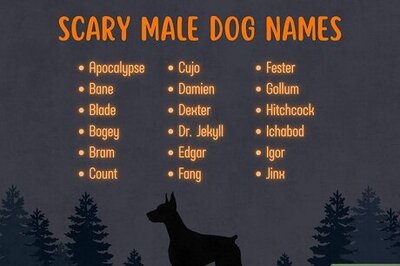
views
Washington: The five permanent members of the UN Security Council and Germany will resume talks in Moscow on Wednesday to solve the Iranian nuclear crisis after they were unable to reach a consensus Tuesday.
Senior officials from the countries meeting on Tuesday evening failed to settle differences over how to curb Iran's nuclear program, which has been deemed in breach of International Atomic Energy Agency (IAEA) safeguards.
On March 29, the Security Council called on Iran to suspend its uranium enrichment activities and told the IAEA to report on Iran's compliance within 30 days.
The United States has been pushing for sanctions to be imposed on Iran.
Senior officials said US Undersecretary of State, Nick Burns, made the case in Moscow that the credibility of the United Nations was at stake, and that continued Iranian defiance of international demands would undermine the legitimacy of the world body.
The group in Moscow included the five permanent members of the Security Council - the United States, Britain, France, Russia and China - along with Germany, which has been involved in talks with Iran.
Representatives held a three-hour dinner to discuss the Iran nuclear issue, said State Department spokesman Tom Casey.
While they all agreed Iran's actions this week were a negative development and that further discussion about UN action was needed, Casey said there was no agreement on the issue of sanctions.
Iran's pursuit of uranium enrichment has put it at odds with the United States and European governments, which fear the program could be used to produce nuclear weapons.
Iran says it does not want to produce a nuclear bomb, but has a right to pursue nuclear energy under the 1968 Non-Proliferation Treaty.
IAEA Director General Mohamed ElBaradei is due to report to the Security Council by the end of April on the Iranian issue.
Iranian President Mahmoud Ahmadinejad announced last week that his country had produced a small amount of enriched uranium at Natanz in concentrations capable of running a nuclear power plant - a level far below that needed for a nuclear weapon.
The UN Security Council has called on Iran to halt uranium enrichment work, and the diplomatic confrontation has led to reports that the United States and Israel have drawn up plans to bomb Iran's nuclear research plants - reports US President George Bush dismissed as 'wild speculation' last week.
The United States is looking for the UN Security Council to pass a resolution under the UN charter requiring Iran to comply with international law.
PAGE_BREAK
The Bush administration wants the council to impose sanctions against Iran, including a freezing of assets and travel ban against members of the regime and a tightening of export controls to slow the development of Iran's nuclear program.
On Tuesday, Bush refused to rule out military action against Iran if diplomatic efforts failed.
He said he would discuss Iran's nuclear program with Chinese President Hu Jintao when the two leaders meet this week.
"All options are on the table," Bush said. "We want to solve this issue diplomatically, and we're working hard to do so."
As Iran celebrated its Army Day with a large scale parade, Ahmadinejad warned the Iranian army was like a 'meteorite' that would 'cut off the hand of any aggressor and leave the enemy covered in shame'.
On Wednesday, the Moscow talks will also include Canada and Italy, which are members of the Group of Eight Industrialized Countries.
US State Department spokesman Sean McCormack said the meeting on Wednesday will provide "another opportunity in a different forum to talk about what are the diplomatic means to increase pressure on the Iranian regime."
The Moscow discussions come as UN nuclear inspectors say they want to know more about Ahmadinejad's assertion that Iran is now researching and testing a more powerful uranium-enrichment centrifuge technology, known as P-2.
An official at the International Atomic Energy Agency (IAEA) said Monday that Ahmadinejad's claim, made in a speech last week, would be a key area for the inspectors.
P-2 centrifuges, with their superstrong rotors, enrich uranium faster, and could help Iranian scientists construct a nuclear weapon much sooner than the P-1 centrifuges they have shown to international inspectors.
Ahmadinejad said Iran is "now under the process of research and testing" of P-2 technology, but it was not clear from his statement whether he was saying Iran has P-2 centrifuges.
IAEA officials said the subject of P-2 work never came up during last week's meetings between ElBaradei and Iranian officials.
Team inspections
The team, which is scheduled to inspect nuclear facilities at Natanz, is to be led by Olli Heinonen of Finland, the agency's deputy director general and head of the Department of Safeguards.
The inspectors will arrive in Iran on Friday to visit the nuclear sites, including Natanz, a senior Iranian official said Tuesday.
Until now, Iranian officials have said that they stopped all work on P-2 technology years ago after receiving blueprints for a centrifuge from the black-market syndicate run by Pakistani scientist AQ Khan in 1994.
PAGE_BREAK
The official said the team will also seek clarification on a number of other "mysterious gaps" in the evidence concerning Iran's nuclear program during the roughly 17 years when Iranian officials lied about it, and concealed the work from the world.
The latest tensions helped push oil to $72 a barrel.
White House reaction
"Undisclosed work on P-2 centrifuges would be a further violation of Iran's safeguard obligations, in addition to those that have already been identified by the board of the International Atomic Energy Agency," White House spokesman Scott McClellan said Monday.
"Such violations and failures by the regime to comply with its international obligations run contrary to the regime's claims that its nuclear program is solely for peaceful purposes."
BSA Tahir, an associate of Khan, now in prison in Malaysia, has been reported as saying Iran received far more P-2 technology than it has acknowledged.
US intelligence officials estimate, based on the assumption that Iran has only P-1 centrifuges, that it is five to 10 years away from making a nuclear weapon.
A report released last weekend by a US-based nuclear watchdog group said commercial satellite photos indicate Iran has begun to expand its nuclear fuel plants and has buried one beneath dozens of feet of earth and concrete.
Analysts for the Institute for Science and International Security spotted what they said were new tunnel entrances at the Isfahan uranium conversion plant and the Natanz uranium enrichment plant.
Ahmadinejad announced last week that his country had produced a small amount of enriched uranium at Natanz in concentrations capable of running a nuclear power plant -- a level far below that needed for a nuclear weapon.
The pilot program at Natanz used a cascade of 164 centrifuges, Iranian officials said.
Tens of thousands of centrifuges are needed to produce enough enriched uranium to produce fuel for a reactor or for nuclear weapons.




















Comments
0 comment